Al-Jdayde
| Al-Jdayde (Aleppo) | |
|---|---|
| Native name Arabic: جديدة | |
| Al-Jdeideh, Al-Judayda | |
 Al-Jdayde, district of Aleppo as seen in 1920 | |
| Location | Aleppo, Syria |
| Coordinates | 36°12′25.0″N 37°09′24.4″E / 36.206944°N 37.156778°ECoordinates: 36°12′25.0″N 37°09′24.4″E / 36.206944°N 37.156778°E |
| Built | Late 14th Century |
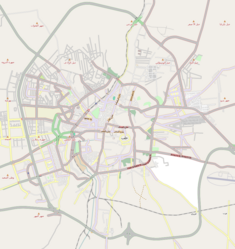 Location of Al-Jdayde (Aleppo) in Aleppo | |
- For similarly named places, please see Al-Jdayde (disambiguation).
Al-Jdayde (Arabic: جديدة, also transliterated as al-Jdeideh, al-Judayda, al-Jdeïdé or al-Jadida) is a historic predominantly Christian neighbourhood of Aleppo. It is noted for its winding narrow alleys, richly decorated mansions and churches. It was an area of significant cultural and historical interest. Much of Al-Jdayde suffered catastrophic damage during the Syrian civil war.[1]
History[]

At the end of the Mamluk period, al-Jdayde was a small suburb benefiting from a few shops located outside of city's northern walls and near the cemeteries and storage areas. The development of the city along the roads connecting the Bab al-Nasr gate with neighbouring villages to the North and northeast progressively integrated Jdayde into the city of Aleppo.[2]
By the late 14th century, these quarters were equipped with khutba mosques and fountains made possible by a network of water works. A new water duct, opened in 1490–91, facilitated the further extension of the Jdayde neighbourhood and the creation of its hammams.[3] Christian cemeteries and probably also the remains of ancient churches of the Byzantine period are to be found in the West side of the al-Jdayde suburb. The earlier settlement of in this ancient Christian sector, followed by the development of Jdayde, reflects the growth of the Christian population and its desire to reside together in specific areas.[4]
Most churches, newly built or enlarged, are found around Farhat Square next to the Salibeh intersection, notably, the Armenian Holy Forty Martyrs Church which was enlarged in 1490,[5] the Greek Orthodox, the Maronite and the Syriac churches.[6] The neighbourhood was gradually settled by notables as well as less affluent residents.[7]
Character[]
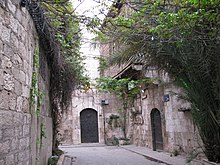
The Armenians, who specialized in trade with Persia and India, were the predominant inhabitants of Jdeideh.[8] During the 16th and 17th centuries, following the Ottoman conquest, the neighbourhood was subdivided into rectangular land parcels.[9] Two large Muslim waqfs (religious trusts), founded in 1583-90 and in 1653, have been in the heart of the area for centuries.[10]
These two architectural ensembles, with richly decorated facades and regular layout, hosted the majority of the commercial and social services for the neighbourhood, where Muslim and Christian, rich and poor, lived side by side.[11] They included a fountain in front of the Christian quarter, a café, a large hammam, a small mosque and a school for Muslim pupils, a cloth market, four large textile workshops,[12] a vast cereal warehouse, and various souks for food and local services.[13]
Here numbers of locals and dragomen would, with the encouragement of various sultans, assist foreign merchants conduct their trade in Aleppo.[14]
Revitalisation[]

In 1990–2000, al-Jdayde—noted for its winding narrow alleys, richly decorated mansions and churches—became an area of significant cultural, historical and tourist interest for national and international visitors.[15][16] An ever-present scent of flowers, especially Jasmin, was said to permeate the area.[17]
Many of the neighbourhood's historic palaces were revitalised as museums, boutique hotels and restaurants. Some of the most important historic buildings of the al-Jdayde quarter include: ,[18] Beit Ghazaleh,[19] , Beit Achiqbash, , , [20] and .[21][22]
Jdayde's two squares, Sahat Farhat and Sahat Al Hatab were also renovated during this period.[23][24]
Recent Developments[]
Much of al-Jdayde suffered catastrophic damage during the Syrian civil war which began in Aleppo in 2012.[25][26][27] The area found itself on the front line of a four-year war of attrition between combatant forces.[28][29][30]
In particular, a series of huge underground explosions[31] conducted by the armed opposition under Sahat Al Hatab in April 2015 devastated the neighbourhood.[32][33][34] A number of monuments, museums, churches including Beit Ghazaleh, Beit Achiqbash and the Waqf of Ibshir Mustafa Pasha, were heavily damaged by fighting.[35][36][37] Furthermore, numerous buildings were stripped of their fixtures and fittings and ancient decorations looted.[38][39]
A collaborative high precision survey of various monuments in the zone were completed in November 2017 by the DGAM and UNESCO to facilitate their protection and emergency consolidation.[40][41][42] The process of the rehabilitation of Sahat al Hatab, which began with back-filling of craters in 2017, continued with rubble clearance in 2018.[43][44][45][46]
Bibliography[]
- David, Jean-Claude (1990), "L'espace des chrétiens à Alep. Ségrégation et mixité, stratégies communautaires (1750-1850)." Revue du monde musulman et de la Méditerranée, 55-56:1-2, pp. 150–170;
- Edhem Eldem, Daniel Goffman, and Bruce Masters (1999), "The Ottoman City between East and West: Aleppo, Izmir, and Istanbul." Cambridge: Cambridge University Press, pp. 244.
- Watenpaugh, Heghnar Zeitlian (2004), "The image of an Ottoman city: imperial architecture and urban experience in Aleppo in the 16th and 17th centuries", Leiden: E.J. Brill, pp. 278.
- Salle, Eusèbe de, (1840) Pérégrinations en Orient, ou Voyage pittoresque, historique et politique en Égypte, Nubie, Syrie, Turquie, Grèce pendant les années 1837-38-39. T. 2, Pagnerre (Paris) p. 194-200.
- Ebru Miroğlu (2005) "The transformation of urban space at the conjunction of the old and new districts: the city of Aleppo" [MSc Thesis] Middle East Technical University (Ankara)
- Ross Burns & Stefan Knost (2020) "Judayda Churches | كنائس الجْدَيْدِة". L.I.S.A. WISSENSCHAFTSPORTAL GERDA HENKEL STIFTUNG (in English and Arabic).
- Winter, S., & Ade, M. (Eds.). (2020). Aleppo and its Hinterland in the Ottoman Period / Alep et sa province à l’époque ottomane. Leiden, The Netherlands: Brill.
See also[]
- Christianity in Syria
- Sahat al Hatab
- Sahat al Farhat
- Al Jdayde churches, history and damage report
- Beit Achijbash
- Beit Ghazaleh
Gallery[]

Windows of Dar Zamariya in al-Jdayde (postcard 1918-22)

Beit Sissi, a mansion renovated as piano bar

The Hokedun alley at the Armenian quarter of al-Jdayde

A narrow alley towards the Farhat Square
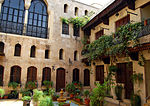
Beit Wakil, a mansion renovated and converted into a boutique hotel

An Armenian school at the old quarter of al-Jdayde
Courtyard of the Ajikbash House Museum
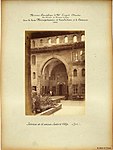
Interior of the Maison (Beit) Sader as seen in 1880
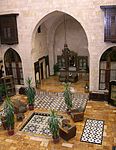
Dar Zamaria, a mansion converted into boutique hotel
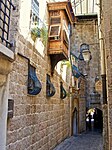
Al-Yasmeen alley in al-Jdayde
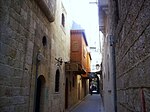
Dar Basile in al-Jdayde
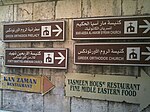
Bilingual street signs referring to church locations in al-Jdayde
References[]
- ^ Mackenzie, Laura (2019-07-15). "Rebuilding Aleppo: 'We cannot preserve the place but we can save our memories'". The Guardian. ISSN 0261-3077. Retrieved 2019-07-18.
- ^ Hazzazé to the north-west, Ramadaniyé to the north-east and Banqousa to the east
- ^ Sauvaget, Jean (1941) Alep, essai sur le développement d’une grande ville syrienne des origines au milieu du XIXe siècle, texte et album, librairie orientaliste Paul Geuthner, Paris : Carte des canalisations mameloukes, p. 182.
- ^ Heghnar Zeitlian Watenpaugh (2004), The image of an Ottoman city: imperial architecture and urban experience in Aleppo in the 16th and 17th centuries, Leiden: EJ Brill, pp. 158-9
- ^ Sauvaget (1941) p. 179.
- ^ Ross Burns & Stefan Knost. "Judayda Churches | كنائس الجْدَيْدِة". L.I.S.A. WISSENSCHAFTSPORTAL GERDA HENKEL STIFTUNG (in English and Arabic). Retrieved 2020-02-13.
- ^ Churches and houses shared the same principle of discretion with an absence of facades shown on exterior elevations especially on the main streets. It seems that certain churches may have had their entrances at the end of cul-de-sacs.
- ^ Semerdjian, Elyse (2019-10-10). "Armenians in the Production of Urban Space in Early Modern Judayda, Aleppo". Aleppo and Its Hinterland in the Ottoman Period: 28–61. doi:10.1163/9789004414006_003. ISBN 9789004414006.
- ^ David, Jean-Claude. (1982) « Urbanisation spontanée et planification » Les cahiers de la recherche architecturale, n°10-11.
- ^ David, Jean-Claude (2015-03-16). Le Waqf d'Ipšīr Pāšā à Alep (1063-1653) : Étude d'urbanisme historique. Études arabes, médiévales et modernes (in French). Beyrouth: Presses de l’Ifpo. ISBN 978-2-35159-507-7.
- ^ Mansel, Philip (2016). Aleppo: The Rise and Fall of Syria's Great Merchant City. I.B.Tauris. p. 28. ISBN 9781784534615.
- ^ The three qaysariya du waqf Ipchir Pacha have been held more than eighty textile operations each with two to four looms thus possibly hosted more than 250 craftsmen at the peak of activities in the area.
- ^ David, Jean-Claude, (2004) « La production de l’espace dans la ville ottomane » Les relations entre musulmans et chrétiens dans le Bilad al-Cham, p. 178–179.
- ^ Burns, Ross (2016-08-25). Aleppo: A History. Routledge. pp. 231–2. ISBN 9781134844081.
- ^ Stefano Bianca, Peter Davies, Wolfgang Fülscher (1981-3) The Re-development of the Bab Al-Faraj Area in Aleppo, UNESCO PARIS p. 9 (36)
- ^ Sabbagh, Lamia (15 November 2016). "Aleppo Houses". prezi.com. Retrieved 2017-07-23.
- ^ Tharoor, Maryam Maruf and Kanishk (2017-06-10). "Return to Aleppo: The story of my home during the war". BBC News. Retrieved 2017-06-10.
- ^ "Aleppo | Bayt Wakil | Archnet". archnet.org. Retrieved 2017-05-17.
- ^ "Courtyard view to iwan | Archnet". archnet.org. Retrieved 2017-05-17.
- ^ "Bayt Basil | Detail of tiles in courtyard | Archnet". archnet.org. Retrieved 2017-05-17.
- ^ "Bayt Dallal | Courtyard view towards reception hall | Archnet". archnet.org. Retrieved 2017-05-17.
- ^ Salle, Eusèbe de (1796-1873) Auteur du texte (1840). Pérégrinations en Orient, ou Voyage pittoresque, historique et politique en Égypte, Nubie, Syrie, Turquie, Grèce pendant les années 1837-38-39. T. 2 / par Eusèbe de Salle,... (in French).
- ^ Darke, Diana (2010-01-01). Syria. Bradt Travel Guides. ISBN 9781841623146.
- ^ Bairs-Zars, Bernadette (May 2017). Developing heritage: activist decision-makers and reproducing narratives in the Old City of Aleppo, Syria (PDF) (Thesis). Massachusetts Institute of Technology, Departement of Urban Studies and Planning. p. 183.
- ^ "Syria: Christians take up arms for first time". Telegraph.co.uk. Retrieved 2016-12-09.
- ^ "Aleppo's famed Old City left 'unrecognisable' by war". Al-Monitor. 2017-01-01. Retrieved 2017-01-01.
- ^ David, Jean-Claude; Boissière, Thierry (2013). "La destruction du patrimoine culturel à Alep : banalité d'un fait de guerre ?". Confluences [en] Méditerranée (in French). 89 (2): 163. doi:10.3917/come.089.0163.
- ^ "Aleppo's famed Old City left 'unrecognisable' by war". Al-Monitor. 2016-12-30. Retrieved 2016-12-30.
- ^ Ministry of Culture Directorate General of Antiquities & Museums (2017) STATE PARTY REPORT On The State of Conservation of The Syrian Cultural Heritage Sites (Syrian Arab Republic), 1 February 2017, available on https://whc.unesco.org/document/155953
- ^ "Aleppo After the Fall". Retrieved 2017-05-27.
- ^ "Old Aleppo: Tunnels were exploded and bombings with TNT barrels – APSA". apsa2011.com. 15 May 2015. Archived from the original on 4 October 2016. Retrieved 2017-05-20.
- ^ jdeideh jdayde (2015-04-30), Al Jdeideh Jdayde April 2015 Sahet Al-Hatab Square Aleppo, retrieved 2016-12-09
- ^ "Damage Assessment of Aleppo, Aleppo Governorate, Syria (10 Jul 2015)". ReliefWeb. 2015-07-22. Retrieved 2016-12-09.
- ^ "ASOR Cultural Heritage Initiatives Weekly Report 38 (April 27, 2015)". ASOR Cultural Heritage Initiatives. 2015-05-28. Retrieved 2017-01-03.
- ^ Centre, UNESCO World Heritage. "UNESCO reports on extensive damage in first emergency assessment mission to Aleppo". whc.unesco.org. Retrieved 2018-06-05.
- ^ Stiftung Gerda Henkel (August 2017). "The Waqf of Ibshir Mustafa Pasha - Damage Assessment | تقييم الضرر". L.I.S.A. WISSENSCHAFTSPORTAL GERDA HENKEL STIFTUNG. Retrieved 2019-06-14.
- ^ Rami Al-Afandi, Issam Ballouz, Alaa Haddad, York Rieffel. "Al-Judayda Churches Rapid Damage Assessment". The Churches of the Judayda Quarter. Retrieved 13 February 2020.CS1 maint: multiple names: authors list (link)
- ^ David, Jean-Claude. "La guerre d'Alep 2012-2016. Destruction de la maison Ghazalé (Jdeideh )". ArchéOrient - Le Blog (in French). Retrieved 2018-04-16.
- ^ "Pro-Iran Militants Loot Aleppo's Antiquities". The Syrian Observer. 2019-06-27. Retrieved 2020-09-07.
- ^ Art Graphique & Patrimoine (2017-11-28), Relevé et nuage de points de Beit Ghazaleh, Alep - Syrie (mission UNESCO), retrieved 2018-10-09
- ^ "Can technology help restore Syria's lost archaeological heritage?". The National. Retrieved 2018-10-09.
- ^ There, Out. "Can We Rebuild Aleppo Using New Technologies?". www.outthere.fr. Retrieved 2018-10-09.
- ^ "Aleppo's Old City can be rebuilt: UNESCO". The Daily Star Newspaper - Lebanon. 2017-08-04. Retrieved 2018-06-05.
- ^ Sergei Pushkarev. "Slowly but steadily, Aleppians remove debris from streets, thanks to @UndpSyria @swissDev @JapanGov paving the way for livelihoods and economic activity coming back to this majestic city". Twitter. Retrieved 2018-10-09.
- ^ Kousa, Christine; Pottgiesser, Uta (2019-01-01). "Post Syrian-war material recovery, reuse and transformation in the Old City of Aleppo". Journal of Cultural Heritage Management and Sustainable Development. 10 (1): 90–103. doi:10.1108/JCHMSD-07-2019-0085. ISSN 2044-1266.
- ^ Qudsi, Jwanah. "Rebuilding Old Aleppo | Postwar Sustainable Recovery and Urban Refugee Resettlement". Cite journal requires
|journal=(help)
| Wikimedia Commons has media related to Jdeydeh quarter. |
- Jdeydeh quarter
- Christian communities in Syria
- Tourist attractions in Syria












